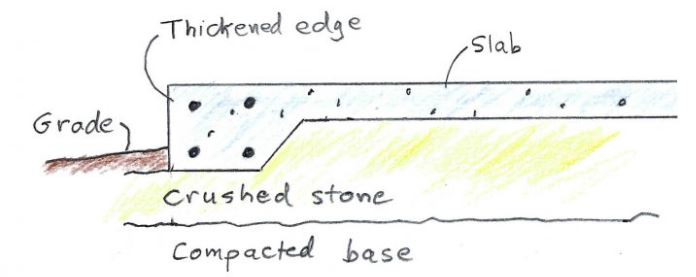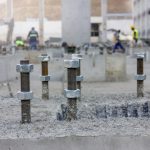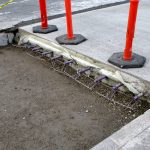
A turndown slab is one that has edges which are thicker than other parts of the slab. They are popular in concrete construction because of their durability and serve as a means of installing a slab and footing at the same time. In this article, you will learn more about the turndown slab, review requirements for its detailing, and compare a turndown slab vs a monolithic slab.
More on Turndown Slabs
Generally, there are different types of concrete slabs such as waffle, raft, monolithic, etc. Selecting the appropriate slab for an application depends on factors such as the type of structure, soil conditions, and the finished floor level. On its own, turndown slab is not a type of concrete slab per se. Rather, it refers to slabs where an edge or multiple edges are thickened to improve strength. Typically, the edges set aside for thickening are those that experience the most loads according to structural analysis. Some of the reasons for making slabs this way include:
- The edges could be providing support for another structure such as wall. So, they are thicker to improve the robustness at such points.
- Also, in temperate regions, it could be to provide resistance against frost heaving.
- Another reason for a turndown slab is to allow for easy drainage in areas such as patios. Using it provides the necessary pitch so that water does not pool on the surface. Thus, offering a cheaper option than a retaining wall.
How to Construct a Slab-on-Grade Turndown
A turndown is common on several types of concrete foundations, especially the slab-on-grade. Steps to constructing a slab-on-grade turndown are as follows:
- Grade the subgrade to between 1 to 5.5-inches of the final elevation of the slab. A skid steer loader is ideal for this job.
- Fabricate forms for the turndown slab edges using boards and level the boards to the preset height of the slab. Generally, 2 by 12-inch boards are ideal for a 5-inch slab.
- Next, brace the boards, typically at 2-feet intervals, and drive them into the ground to just below to just below the top of the form. Ensure that all boards are square and straight after driving, then lubricate them using low-grade oil or a suitable alternative.
- Place well-drained gravel in the form for the subbase in a way that it slopes, but is also uniform. Start by filling along the edges, leaving a 12 by 12-inch trench before compacting. Then, add 4-inches of fine gravel as the base course and compact again.
- If the turndown slab will experience heating, cover this base fill with sheeting before installing steel rebars around the perimeter from top to bottom. Also install welded wire mesh on the surface and ensure 2-inches of cover of the steel.
- Plan and mark the position of doorways, anchor bolts for wall sill plates, control joints, etc.
- Finally, pour the concrete that meets specifications for compressive strength and workability, and finish to the desired texture. Cure for at least 3 days and remove forms carefully.

Turndown Slab Detail
Detailing is key to communication among professionals in the design and installation of concrete structures. Because it is a design drawing that shows the size, location, placement, type, termination of reinforcement, and other key attributes. These designs follow requirements from industry standards such as ACI PRC-315-18 and IS 456.
IS 456 Concrete Slab Detailing Requirements
- Nominal Cover: The nominal cover is the distance between the exposed surface of the turndown slab and the nearest reinforcement bar. If the diameter of the bar exceeds 12-mm, then the nominal cover for mild exposure and moderate exposure should be 20-mm and 30-mm, respectively. However, if the diameter of the bar is 12-mm or below, the cover may be reduced by 5-mm. In any case, the nominal cover should not be less than the diameter of the bar.
- Maximum Bar Diameter: IS 456 recommends that the diameter of reinforcement bars in any slab, including a turndown slab, does not exceed 1/8th of the slab thickness.
- Spacing of Bars: For main steel, the maximum spacing of bars shall not exceed three times the effective cover or 300-mm, whichever is smaller. While for distribution steel, the spacing shall not exceed five times the effective cover or 450-mm, whichever is smaller. As for the minimum spacing, IS 456 does not recommend any value, but it is generally kept above 75-mm.
- Minimum Reinforcement: In either direction, the reinforcement shall not be less than 0.15% of the total cross-sectional area for Fe-250 steel. While for Fe-415 and Fe-500, the reinforcement in either direction shall not be less than 0.12%.
Turndown Slab vs Monolithic Slab
| Turndown Slab | Monolithic Slab |
| The edges are thicker than other sections of the slab. | Has uniform thickness across the entire slab. |
| Because of the thicker edges of a turndown slab, it prevents frost heaving and provides better support for exterior walls. | Usually susceptible to frost heaving and damage to edges due to stress from exterior walls. |
| Also, the thicker edges make it less susceptible to erosion and crack progression. | Because the slab is a single piece with the same thickness, cracks can progress easily. |
| The thicker edge of the slab serves as a footing, so the entire concrete can be poured at once. | When using monolithic slabs with footings, the concrete for the footing is poured first before that of the slab. |



